Drag kills drifts. On the surface or under, it’s an enemy to every fly fisher, destroying the elusive dead drift and turning good presentations bad. Luckily, the right leader, tippet and casting stroke can beat drag long enough to trick even the fussiest fish.
Imitating a naturally drifting insect is at the heart of fly fishing and for many is the baseline approach. Let’s set aside swung wet flies, nymphs and streamers for a while, and deal with the roots— the top water game—the foundation of modern fly fishing.
To fool most trout, we need flies that drift with the current, not against or across it. We need a natural dead drift, and we need to read surface currents. Once an angler has mastered eliminating drag on the dry, fly selection becomes easier as a trout is far more likely to refuse a fly because of surface drag than because of pattern.
Sure, changing the fly sometimes changes a trout’s mind. Show him something different, and he might take it. But was it the pattern change? Or is the new fly a better match for the leader and tippet, and thus incurring less drag? Let’s talk about that.
Harvey Style
I’m a believer in George Harvey’s concept for dry fly leaders. Harvey teaches that leaders should be designed to land in s-curves. We want slack on the water, before the dry, and especially in the tippet section. The leader should not straighten out, but land in curves and circles. That slack is then pulled out by the currents; the curves unwind as the fly progresses downstream, as conflicting currents pull on the leader at varying speeds. Without some slack on the water (without those curves and circles), the fly often drags as soon as it hits the surface.
Harvey offers two basic leader formulas in his 1985 book, Techniques of Trout Fishing and Fly Tying. Those formulas and the Joe Humphries variations are an excellent guide for adapting dry fly leaders.
Importantly, Harvey’s dry fly leader has a stiff, but relatively thin, butt section and a limp, soft tippet section. It fishes much differently than a manufactured, tapered leader, most of which are designed to lay out straight.
Here’s my standard dry fly leader
20” — 20# Maxima Chameleon
18” — 15# Maxima Chameleon
18” — 13# Maxima Chameleon
12” — 10# Maxima Chameleon
8” — 8# Gold Stren
12” — 2X nylon tippet material
12” — 3X nylon tippet material
14” — 4X nylon tippet material
20-48” — 4X, 5X or 6X nylon tippet material (to match fly and conditions)
I like thin butts
Most leaders from a package come with thick butt sections. Harvey’s leaders call for .015” or .017”, while manufactured leaders commonly have butt sections of .022-.024”.
Do you think that’s only a small difference? It’s not. Thinner butts flex more and they curve more, while thick butts lay out straight.
Additionally, Harvey argues that the butt section of a leader should match the flexibility at the end of the fly line, not the diameter. It’s another important concept.

Not the Same
Here’s another point: my leader won’t fit your situation. It doesn’t even fit my own situation for very long. As I learned from Harvey and Humphreys, the leader should be adapted to the circumstances. If I move to small water, I may cut back the butt sections. When I change from a #12 Parachute Adams to a #18 Blue Winged Olive, I might cut back the 4X and tie on a long section of 5X.
What tippet size? What length?
Match the tippet size to the wind resistance of the fly. With the limpness of modern nylon tippets, I rarely need to go below 5X. And even for Tricos and midges, I fish 6X. For me, tippet size is determined by how big I can get away with and still have the fly move naturally (e.g., a #20 BWO will not flex on 4X tippet, so I use 6X).
How long should it be? We’ll get to that in a minute ...
You better check yourself
The style and execution of the cast is just as important as tippet size and length. Ten-o-clock and two-o-clock, right? Everyone knows these basics of fly casting? Half of us learned it from Norman Maclean.
But we must accelerate in between those two positions and then forcefully stop at those positions. The acceleration and abrupt stop is what makes good fly casting, and in this case, it creates the necessary slack for a dry fly to drift without drag.
In a recent podcast I heard that the last forward cast (after false casting a bunch) should flatten out, point to the target, and finish with the rod parallel to the water surface. Ummm … not really.
I think they left out some important points. First, don’t false cast any more than needed. Second, the forward cast (the delivery) should be stopped hard, checked high, and only then dropped parallel with the surface. Harvey says to check forcefully so the leader and fly are delivered 3-4 feet above the surface. Only then let the rod point to the target and lay parallel with the water. If the leader and tippet is adjusted properly for the fly, it will land in s-curves.
I think of this as the Harvey check, and it’s the heart of a good dry fly presentation. Stop the rod tip high and check it hard. The leader straightens and recoils a bit, Then when the rod is laid parallel with the surface, the leader lands in s-curves.
Curve casts?
You can do something similar with curve casts, and when the river bends and winds in cooperation with where I’m standing, I sometime use curve casts. But the Harvey check works more consistently to deliver s-curves into the leader.
Leader. Tippet. Cast.
There’s nothing more rewarding than covering a bunch of water, poking a dry fly into every shady corner, and looking for energetic takers, all while watching the river for the next rising target. The key to success in the dry fly game starts with drag free drifts as a baseline. For that, the dry needs some slack to unfold gently behind it without pulling the dry off course. The right leader and tippet, matched with a good Harvey check fools a lot of trout.




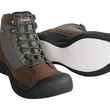


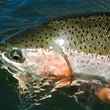




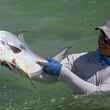



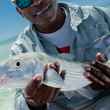




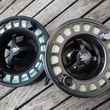




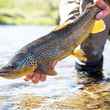




Comments
Miggity replied on Permalink
What Humpreys book is referenced in this article?
Terry martin replied on Permalink
Why do you use the gold Sten. You start with the maxima Chameleon line which is dark. Then 8" of gold stren. Then you add tippet
I build something similar but I go 24" 20lb chameleon then 18" 13lb chameleon then 18" 10lb then I add 8" of each 2x,3x,4x. Then finish with 5x and add 6x if I am using smaller flys
I just was curious
Fred Rickson replied on Permalink
It might not be as intuitive with stillwater as in moving water, but drag effects success here as well. With drys, you cast into the wind (or current if there is one) so your fly moves along the surface with the other food items. If you cast with the wind, and hold the fly stationary, you get a nice stationary bug with all the real food quietly drifting along. The fish seem to notice the difference. With a wet, work the fly against the wind or current because few live bugs just float lazily along as opposed to swimming in a given direction. And, just as the mayflies in the air, nymphs near the surface seem to move against the water direction most often.
PRESTON LARIMER replied on Permalink
I started fly fishing in the 1970's and tied my leaders with Harvey's formulae. many are listed in joe Humphries "Trout Tactics". Humphries was a student of George, and has refined many of his tactics.
I believe that modern tapered leaders are largely designed to mimic (albeit with some problems) these designs, with some crutches thrown in for beginner casters. The heavier butts will turn over easier, and the mid-sections are very aggressively tapered to a supple tip section, much the same as Harvey's transition from 'hard' to 'soft' nylon. However, as a beginner breaks off and replaces a couple of tip sections, they are often in to a very thick midsection, and unless you understand how to rebuild it to Harvey's design, performance of a tapered leader deteriorates very quickly. Hence most people just replace the leader. A leader should last much of the season, while many folks replace them on every trip.
Geo replied on Permalink
It says. "How long should it be? We’ll get to that in a minute ..." bit that minute never arrived......
TC replied on Permalink
Thank you for a truly informative article on fishing. While the essays can be delightful this is the kind of content that i truly appreciate.
Pages